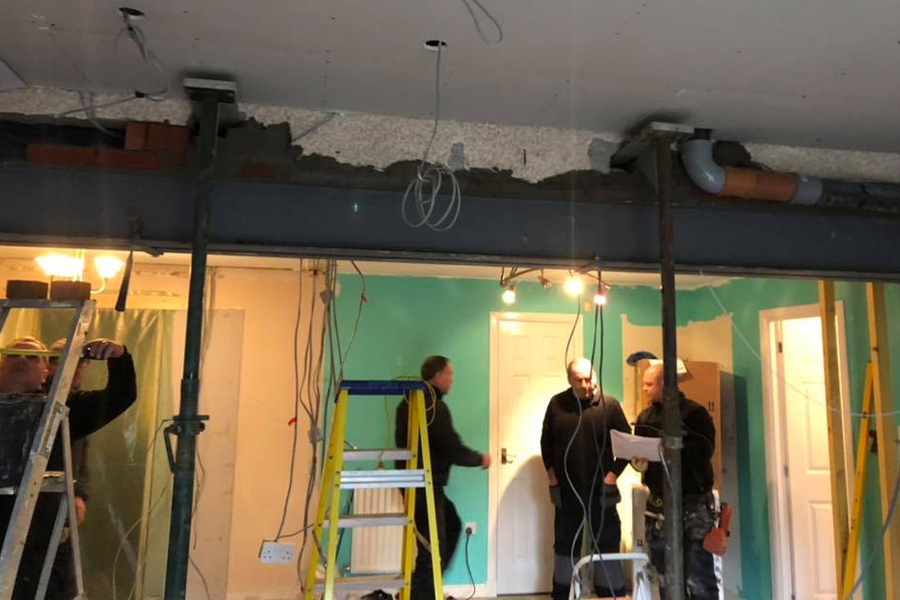The UK property market has seen remarkable activity in recent years. In June 2021 alone, over 213,000 transactions took place—the highest monthly figure since the late 1980s. This surge in property movement has created significant opportunities for homeowners and investors alike.
Alongside this market growth, regulatory changes are reshaping property standards. The upcoming Renters Rights Bill, Awaab’s Law, and stricter EPC targets mean property owners must focus on upgrading their assets. Proper refurbishment work becomes essential for compliance and value enhancement.
A well-executed property refurbishment differs significantly from basic maintenance. It represents a strategic investment that can substantially increase a property’s market value. Careful planning ensures projects stay on budget and meet deadlines while delivering quality results.
This comprehensive approach covers everything from cosmetic updates to structural improvements. Successful projects balance design vision with practical execution, creating spaces that meet modern living standards and regulatory requirements.
Key Takeaways
- The UK property market has experienced unprecedented transaction levels in recent years
- New legislation and energy efficiency standards are driving the need for property upgrades
- Strategic refurbishment differs from maintenance by adding significant value to assets
- Proper planning prevents costly mistakes and ensures projects stay within budget
- Successful projects balance aesthetic design with practical functionality
- Refurbishment work helps properties meet evolving regulatory requirements
- A methodical approach from planning to execution delivers the best results
Refurbishment: Definition, Scope and Benefits
Property enhancement terminology often causes confusion among homeowners and investors alike. Understanding the precise definition of each term ensures appropriate project planning and realistic expectations.
What is Refurbishment?
A clear definition of refurbishment involves improving a property through upgrades like new bathrooms or kitchens. This process focuses on enhancing functionality and appearance without historical preservation concerns.
Common examples include general redecoration and system updates. The scope ranges from cosmetic changes to substantial alterations that increase property value.
Comparing Refurbishment with Renovation and Restoration
These three words represent distinct approaches with different objectives. The key difference lies in their primary focus and outcomes.
Renovation typically restores elements to working condition, like fixing a damaged roof. Restoration emphasises returning a structure to its original historical state.
In contrast, refurbishment involves upgrading components to modern standards. This refurbishment renovation comparison shows how each method serves different property needs.
Understanding these distinctions helps property owners choose the right approach for their specific goals and budget constraints.
Planning Your Property Upgrade Journey
The planning phase is where a property upgrade transforms from an idea into a viable project. A successful approach combines realistic financial planning with a clear understanding of regulatory requirements.
Budgeting and Timeline Strategies
Creating a detailed budget is the first critical step. Costs can vary significantly; a full kitchen refurbishment in 2025 may range from £6,200 to £50,000. Laminate flooring installation averages around £60 per m².
It is wise to factor in a contingency fund of 10-20% for unforeseen issues. A structured timeline should include buffer time for approvals and potential delays, especially in older buildings.
- Obtain multiple quotes from contractors.
- Establish clear payment milestones.
- Phase work to minimise disruption.
Securing Planning Permissions and Compliance
Many upgrade works require planning permission from your local authority. Each council can advise if your specific project needs approval.
For substantial changes like loft conversions, building control services ensure compliance with safety regulations. This process guarantees that all work is structurally sound and meets fire safety standards.
Engaging early with the local authority streamlines this essential refurbishment step, ensuring your property upgrade proceeds legally and safely.
Design Strategies for Modernised Spaces
Modernising a property requires careful consideration of both visible design elements and underlying structural systems. Successful design strategies create harmonious living environments that balance aesthetic appeal with practical functionality.
Aesthetic Enhancements and Material Choices
High-quality material selections significantly impact both appearance and durability. Darker granite countertops resist marking and reduce maintenance needs. Real wooden floors create the impression of larger, more open living areas.
Bathroom refurbishment can increase property value by 4-5% when replacing outdated fixtures. A new kitchen may add 6-8% to a home’s worth. These strategic changes modernise the entire living space effectively.
Incorporating Structural Improvements
Structural upgrades to wiring, plumbing, and ventilation systems are essential refurbishment components. Though less visible than cosmetic changes, they ensure optimal building performance.
Energy efficiency considerations are increasingly important. By 2030, rental properties will require minimum EPC ratings of C. These necessary upgrades support compliance while enhancing overall property value.
Execution and Project Management Techniques
Moving from the planning stage to the active phase marks a critical transition in any property upgrade. Effective execution relies on strong project management to keep the work on track, within budget, and aligned with the original vision.
This phase involves coordinating people, schedules, and materials while being prepared to adapt to unexpected issues.
Selecting the Right Contractors
Assembling a skilled and reliable team is fundamental. Property owners should begin their search by seeking personal recommendations from trusted associates.
Online platforms like Checkatrade.com offer a valuable resource for vetting contractors. They provide access to credentials, customer reviews, and examples of previous work.
Once a contractor is chosen, a detailed written contract is essential. This document formalises the refurbishment scope, agreed costs, and timeframe, protecting all parties.
Managing Unforeseen Challenges
Even with meticulous planning, unexpected problems can arise during a project, especially in older buildings. A contingency budget of 10-20% is a prudent safeguard.
Establishing clear communication channels with the team allows for quick decisions when hidden issues, like outdated wiring, are discovered.
Regular site inspections and photographic documentation help monitor progress. Addressing concerns promptly ensures the process stays on course, leading to a successful refurbishment.
Comparing Refurbishment and Renovation Approaches
The choice between refurbishment and renovation approaches significantly impacts both project outcomes and financial returns. Property owners must understand these distinct strategies to make informed decisions.
Key Distinctions in Process and Outcome
A clear difference exists between these property enhancement methods. Renovation typically restores elements to functional condition using similar materials.
In contrast, the refurbishment renovation approach involves upgrading with superior components. This fundamental difference affects the entire project scope and final results.
The renovation process focuses on repairing existing issues. The refurbishment method transforms spaces through comprehensive upgrades.
Cost, Time and Long-Term Benefits
Renovation projects often require less time and smaller budgets. They address specific problems without dramatic changes.
The refurbishment renovation strategy demands greater investment but delivers superior long-term value. This approach enhances property marketability and rental potential.
Property characteristics guide the appropriate choice. Newer buildings benefit from transformative refurbishment, while historical properties may need careful renovation.
The cumulative effect of selecting the right method ensures optimal resource allocation and maximum property value enhancement.
Financing Your Project: Lending Options and Tax Considerations
Understanding available financing mechanisms enables property owners to execute upgrade projects effectively. The financial dimension requires careful planning to ensure smooth project completion.
Specialist Finance Products for Property Upgrades
Specialist lending services offer tailored solutions for property improvements. Bridging loans provide quick funding, often within days. This speed supports timely project completion.
Investors can access second charge bridging loans without disturbing existing mortgages. These facilities fund conversions and upgrades while maintaining current financing arrangements.
Choosing lenders with proven experience in property renovations ensures better understanding of project risks. They structure payments aligned with work progress.
Understanding Tax Implications
Successful refurbishment increases property value but may trigger higher tax liabilities. Capital gains tax applies when selling at a profit.
Rental income increases after upgrades may raise income tax obligations. Professional tax advice helps identify available allowances and deductibles.
Consulting accountants before starting repairs and improvements optimises tax efficiency. This planning ensures compliance while maximising financial benefits from the refurbishment.
Case Studies and Expert Insights
Learning from successful case studies can significantly improve the outcomes of property enhancement initiatives. This section examines real-world examples and professional perspectives that demonstrate effective strategies.
Industry Insight from Oakwood Properties Ltd
Oakwood Properties Ltd brings decades of experience to complex property work. Their professional team coordinates all aspects of upgrade projects.
Specialist lenders like Market Financial Solutions provide essential services. They work alongside property owners to meet deadlines and ensure timely completion.
This collaborative approach has proven successful across various buildings over many years.
Real Examples and Trends from Oakwood Properties
Oakwood Properties shares valuable examples from completed projects. Their case studies show how strategic planning transforms properties into their best state.
Current trends highlight energy efficiency upgrades and home office spaces. These improvements significantly increase rental income and property value.
For specific project advice, property owners can contact their email service. This provides personalised guidance for unique property challenges.
Conclusion
Property owners who approach upgrades with strategic foresight position themselves for optimal financial returns. Understanding the distinction between refurbishment, renovation, and restoration ensures the right method is chosen for each unique building.
Successful property work balances careful planning with professional execution. This strategic approach transforms living spaces while meeting regulatory requirements.
Each project serves as an example of how thoughtful refurbishment enhances value. The final result reflects the importance of proper planning in every place.
Seeking expert guidance remains crucial for complex property upgrades. Professional input helps navigate challenges and delivers measurable benefits.
The current regulatory environment makes strategic property enhancement increasingly necessary. This concluding word reinforces that careful planning ensures successful outcomes.
FAQ
What exactly is the definition of refurbishment?
Refurbishment refers to the process of improving a building or space by cleaning, repairing, and often updating its fixtures and fittings. The primary goal is to restore the property to a good condition, enhancing its functionality and aesthetic appeal without necessarily altering its fundamental structure.
How does a refurbishment differ from a major renovation?
The main difference lies in the scope of work. A refurbishment typically involves surface-level upgrades, repairs, and cosmetic enhancements, such as repainting or replacing kitchens and bathrooms. A renovation is more extensive, often involving structural changes, conversions, or significant alterations to the building’s layout.
What are the key benefits of undertaking a property refurbishment?
The benefits are multifaceted. It can significantly increase a property’s market value, improve its energy efficiency, and enhance the quality of life for its occupants. For landlords, a well-executed project can lead to higher rental yields and attract better tenants.
What is the typical timeline for a residential refurbishment project?
The timeline varies greatly depending on the project’s scale. A simple refresh of a single room might take a few weeks, while a full-house refurbishment involving multiple tradespeople could span several months. Proper planning is crucial to managing the schedule effectively.
When is planning permission required for a refurbishment?
Planning permission is generally not required for internal refurbishment work that does not alter the building’s external appearance or footprint. However, if the project involves extensions, significant external alterations, or changes to listed buildings, approval from the local planning authority is essential.
How should homeowners approach budgeting for this type of work?
It is advisable to obtain multiple detailed quotes from reputable contractors. Homeowners should also set aside a contingency fund of around 10-20% of the total budget to cover any unforeseen issues that may arise once the work begins, such as hidden structural repairs.
What should one look for when selecting a contractor?
Key factors include checking their credentials, such as memberships in professional bodies like the Federation of Master Builders, reviewing their portfolio of completed projects, and reading testimonials from previous clients. A clear, detailed contract outlining the scope, timeline, and payment schedule is vital.
Are there specialist finance options available for property upgrades?
Yes, several options exist beyond standard personal loans or savings. These include specialist refurbishment finance products, which can be tailored to the project’s scale. Some homeowners may also consider releasing equity from their existing property to fund the work.


 Locked Out? How Total Security Locksmith Handles Emergency Lockout and House Lock Services with Ease
Locked Out? How Total Security Locksmith Handles Emergency Lockout and House Lock Services with Ease  How Takara Standard Kitchens in Singapore Evolve With Every Milestone
How Takara Standard Kitchens in Singapore Evolve With Every Milestone  The Hidden Benefits of Serviced Apartments for Rent in Singapore
The Hidden Benefits of Serviced Apartments for Rent in Singapore  Top 5 Benefits of Installing Roller Blinds in Singapore Homes
Top 5 Benefits of Installing Roller Blinds in Singapore Homes  DIY Log Cabin Christmas Decorations on a Budget
DIY Log Cabin Christmas Decorations on a Budget  Why Homeowners Choose LUKA Design and Build for Timeless Architecture and Modern Function
Why Homeowners Choose LUKA Design and Build for Timeless Architecture and Modern Function  Elevate Your Kitchen or Home Bar with the Right Print
Elevate Your Kitchen or Home Bar with the Right Print  Why Burke Lawn Care Is Northern Virginia’s Go-To for Year-Round Lawn Health
Why Burke Lawn Care Is Northern Virginia’s Go-To for Year-Round Lawn Health  Gardening & Landscape Secrets: Why Home Gardens Deserve More Than a Weekend Trim
Gardening & Landscape Secrets: Why Home Gardens Deserve More Than a Weekend Trim 







